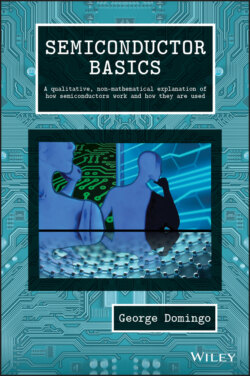Читать книгу Semiconductor Basics - George Domingo - Страница 19
1.7 The Atom's Structure
ОглавлениеWhile all of these light experiments and relationships were being observed in the late nineteenth century, other scientists were playing with cathode‐ray tubes, the precursors of old television sets and oscilloscopes, trying to understand the nature of the atom. The cathode‐ray tube consists of an evacuated tube with two contacts, one at each end: the cathode and the anode. When a voltage is applied across the tube, current flows from the cathode to the anode, and the tube glows. The scientists explained this phenomenon by saying that electrons going through an evacuated tube containing very few atoms are able to attain sufficient velocity (and therefore kinetic energy) to hit the atoms and make them glow. They were called cathode rays.
Nobel Prize winning British physicist Joseph John Thomson (1856–1940, Figure 1.9) studied cathode rays and postulated in 1897 that they consisted of extremely small negatively charged particles, which he initially called “corpuscles.” (As happened with the term photon, George Stoney (1826–1911) later renamed corpuscles as electrons.) By studying how these particles moved through the gas and how they could be deflected by magnets, Thomson concluded that the “corpuscles” were (i) negatively charged particles and (ii) much smaller than the atoms themselves – at least 1000 times smaller. To account for electrically neutral atoms, he proposed that there is a core of positive charges with a large mass surrounded by an amorphous cloud of negatively charged electrons.
Ernest Rutherford (1871–1937, Figure 1.10), also a Nobel Prize winner, worked with radioactivity. In 1911, he bombarded very thin gold foil with alpha particles and looked at the scattered reflections as the radiation went through the foil. Most of the radiation went through the foil undeflected. Only a few alpha particles were reflected back and, from the angle of the reflected radiation, he concluded that the atom must have a very small, concentrated, positively charged core to compensate for the negatively charged electrons. Because the large majority of alpha particles passed through the foil without any directional change, he concluded that the majority of the space in an atom is empty, and the electrons are orbiting the nucleus instead of just being a scrambled negatively charged cloud as Thomson had suggested.
Figure 1.9 Joseph John Thomson and his cathode ray tube.
Source: Wikipedia, https://en.wikipedia.org/wiki/J._J._Thomson#/media/File:JJ_Thomson_Cathode_Ray_2.png (left); Wikipedia, https://en.wikipedia.org/wiki/J._J._Thomson#/media/File:J.J_Thomson.jpg (right).
Figure 1.10 Ernest Rutherford, with his experiment that bombarded alpha particles with radiation, concluded that the nucleus is extremely small and is concentrated at the center of the atom.
Source: Wikipedia, https://upload.wikimedia.org/wikipedia/commons/6/6e/Ernest_Rutherford_LOC.jpg.
Robert Millikan (1868–1953, Figure 1.11) was able to measure the electrical charge of an electron with an interesting oil drop experiment in 1909. He suspended a very small charged oil drop between two metal plates – one positive and the other negative – creating an electric field between the plates. He dropped tiny oil droplets into a vacuum chamber, and with X‐rays, he negatively charged some of the oil drops. By changing the electric field between the two plates, he could control the speed of the oil drops, slowing them down, stopping them, or even moving them upward. By knowing the density of the oil drop, the size of the drop, its volume and mass, and the electric field that compensated for the effect of gravity, he was able to come up with the value of the charge of a single electron: 1.592 × 10−19 coulombs (he was off by less than 1% of the now‐established number – not bad at all).
Figure 1.11 Robert Millikan, with his oil‐drop experiment, measured the electrical charge of an electron.
Source: https://en.wikipedia.org/wiki/Robert_Andrews_Millikan#/media/File:Millikan.jpg.
